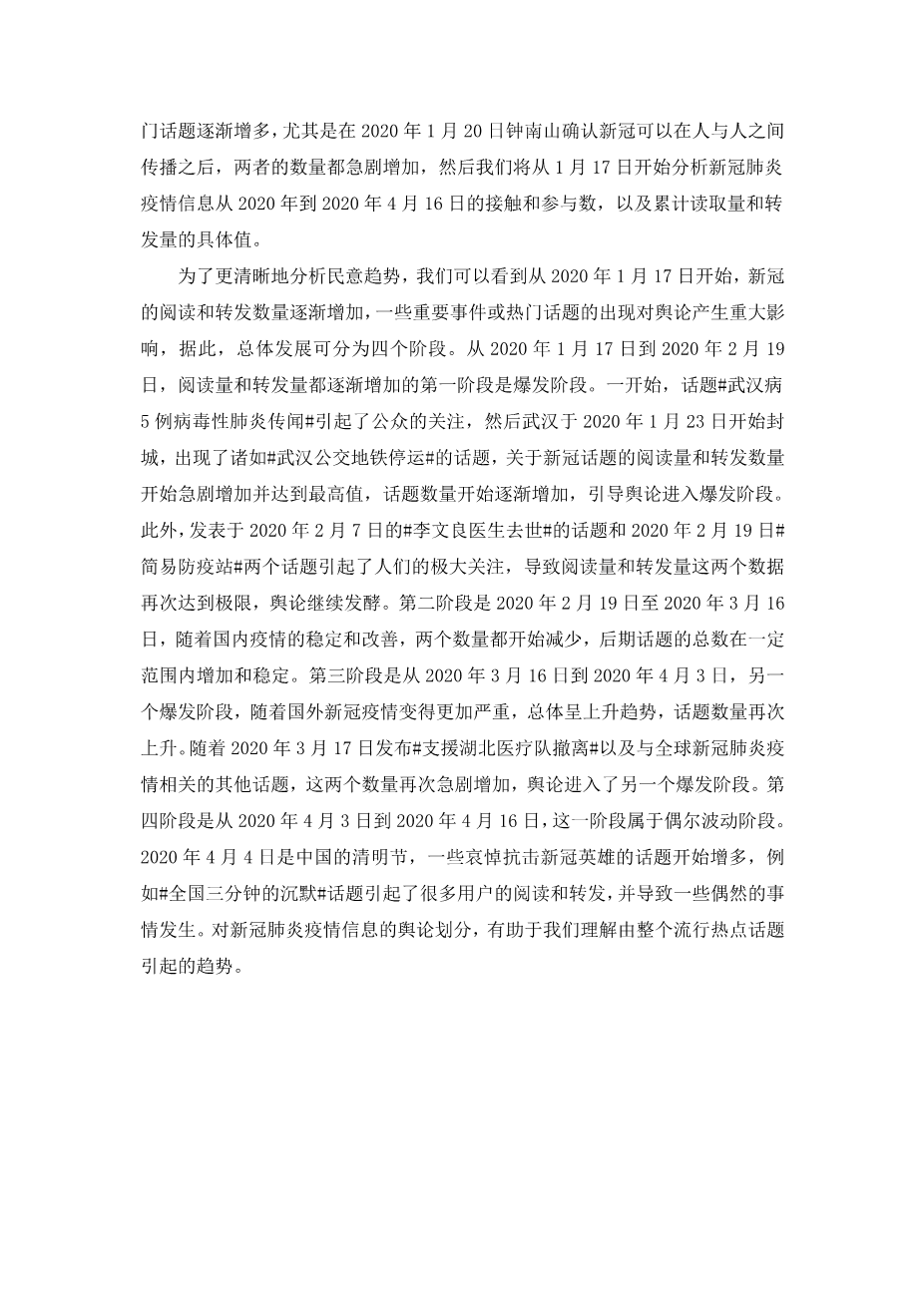COVID-19 information contact and participation analysis and dynamic prediction in the Chinese Sina-microblog
Up to 24:00 on April 16, 2020, 2,352,198 cases have been affected by a novel coronavirus pneumonia (COVID-19) worldwide since it has been successively found in Wuhan. Major news items combined have generated quite strong fluctuations in public opinions. For example, on January 28, 2020, Nanshan Zhong, a well-known expert in infectious disease control, emphasized that people should not go out at present , this appeal attracted wide attention and warning that people said they could go out only if Nanshan Zhong admitted . Sina-microblog is the most popular social network in China and the outbreak-related topics about COVID-19 grew exponentially on that platform. As reading quantity and forwarding quantity of “Nanshan Zhong” have reached almost 9.40 billion and 2.05 million on Sina-microblog, understanding how these emerging public contact and participation spread in social media to alter the public behaviors is important to help to design effective communication strategies for rapid implementation of public health interventions.
The urgency is often accompanied with a number of topics related to the COVID-19 and the behavior of reading and forwarding usually prompts the propagation of the event. Reading is a kind of behavior that reflects usersrsquo; contact in information propagation and forwarding is a kind of behavior that reflects usersrsquo; participation in information propagation. In order to more clearly show the propagation process of both public contact and participation, the network topology describes the state of each node in the network at a certain moment in the process of information dissemination. Taking the propagation of three original post owners under three topics as an example, the userrsquo;s overall state of integrated information propagation is given.
The information posted by the original post owners , and can be read separately by single readers with interest in which readers can then participate in the forwarding about the outbreaks or choose to be silent. Especially, some co-spreaders between different topics repeatedly read and forward the related information successively then become the cross-reading users and cross-forwarding users because of the correlation about the epidemic. Of course, there will also be many readers who contact information choose to be silent, such as the un-forwarding users . In the real-world, the number of information is dynamically changing and cannot be clearly calculated.
The reading quantity and forwarding quantity of the whole COVID-19 are composed of many topics with multiple information. Different from the traditional public hot events, the outbreak is causing great public concern. With the continuous development of the COVID-19, there is a high level of repetition in public reading and forwarding on different topics. As reading is a measure of contact and forwarding is a measure of participation for information dissemination, in this paper, we build the comprehensive susceptible–reading–forwarding–immune (SRFI) dynamics model with considering the repeated behavior including “re-reading” and “re-forwarding” on the impact of public opinion propagation.
Since the outbreak of COVID-19, around 7900 major topics appeared in Sina-microblog. It can be roughly seen that during the period from December 31, 2019 to January 16, 2020, there was only a certain amount of hot topics of COVID-19, however, from January 17, 2020, the hot topics about the epidemic gradually increased, especially after Nanshan Zhong confirmed that the COVID-19 could be transmitted from human to human on January 20, 2020, both the two quantities kept increasing dramatically, and then we will analyze the contact and participation data of COVID-19 information from January 17, 2020 to April 16, 2020 and the specific values of the cumulative reading quantity and forwarding quantity.
In order to analyze the public opinion trend more clearly, we can see that since January 17, 2020, the number of reading and forwarding of COVID-19 has gradually increased, and the emergence of some important events or hot topics has a major impact on public opinion and the overall development can be divided into four stages so far based on this. The first stage, from January 17, 2020 to February 19, 2020, which both two quantities increased gradually, is the outbreak stage. In the beginning, topic # 5 rumors of viral pneumonia in Wuhan # attracted public attention, then Wuhan began its closure on January 23, 2020, with the emergence of topics such as # Wuhan Bus Metro Suspension of Operation #, the reading and forwarding quantities of COVID-19 began to increase dramatically and reached the highest value and the number of topics began to gradually increase leading public opinion enter the outbreak stage. Besides, topic #Doctor Wenliang Li passed away# posted on February 7, 2020 and #Easy epidemic prevention station# posted on February 19, 2020 have aroused great attention from people, causing both two quantities to reach the extreme again and public opinion continues to ferment. The second stage is from February 19, 2020 to March 16, 2020, in which both two quantities start to decrease with the stabilization and improvement of the domestic cases, and the overall number of topics increased and stabilized in a certain range in the later period. The third stage is another outbreak stage from March 16, 2020 to April 3, 2020, the overall trend is on the rise as the disease becomes more serious abroad, and the number of topics has risen again. With the release of #support Hubei Medical Team to evacuate # on March 17, 2020 and other topics related to COVID-19 of the global, both two quantities increased dramatically again, and public opinion entered into another outbreak stage. The fourth stage, from April 3, 2020 to April 16, 2020 is the occasional f
剩余内容已隐藏,支付完成后下载完整资料


英语译文共 2 页,剩余内容已隐藏,支付完成后下载完整资料
资料编号:[406083],资料为PDF文档或Word文档,PDF文档可免费转换为Word
以上是毕业论文外文翻译,课题毕业论文、任务书、文献综述、开题报告、程序设计、图纸设计等资料可联系客服协助查找。


